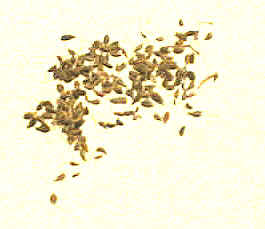|
|
|
|
 Anise
Pimpinella anisum Anise
Pimpinella anisumOrigin Egypt, Greece, Asia Minor Part Used Seeds This shrub is an annual of a foot high with a family resemblance to their spice world cousins, dill, fennel, cumin, and caraway that produces seeds with a licorice and fennel-like flavor. In fact it is the oil distilled from the plant is what gives the distinctive flavor to licorice candy. The seeds are dried and have a greenish brown tone. It was once thought to be a charm against bad dreams and the evil eye. Known as a digestive aid it is popular in drinks, liqueurs and candies. The French use it to sweeten their éclairs and the Italians use it in their Biscotti. It is volatile when bought in ground form and quickly looses it flavor. History There is evidence that the Egyptians used anise as early as 1500 B.C. and in the book of Mathew in the Bible, there is mention of paying tithe with anise and the Roman poet Virgil mentioned in his writings that a sweet cake called "mustaceum" heavily laced with anise was served at the end of heavy banquets to aid digestion. Anise was brought to the New World by settlers from England and in1619, the first Assembly of Virginia announced that each family that was given a plot of land was required to grow certain plants, among them was required six anise plants. Available whole seed, extract, or ground
|
